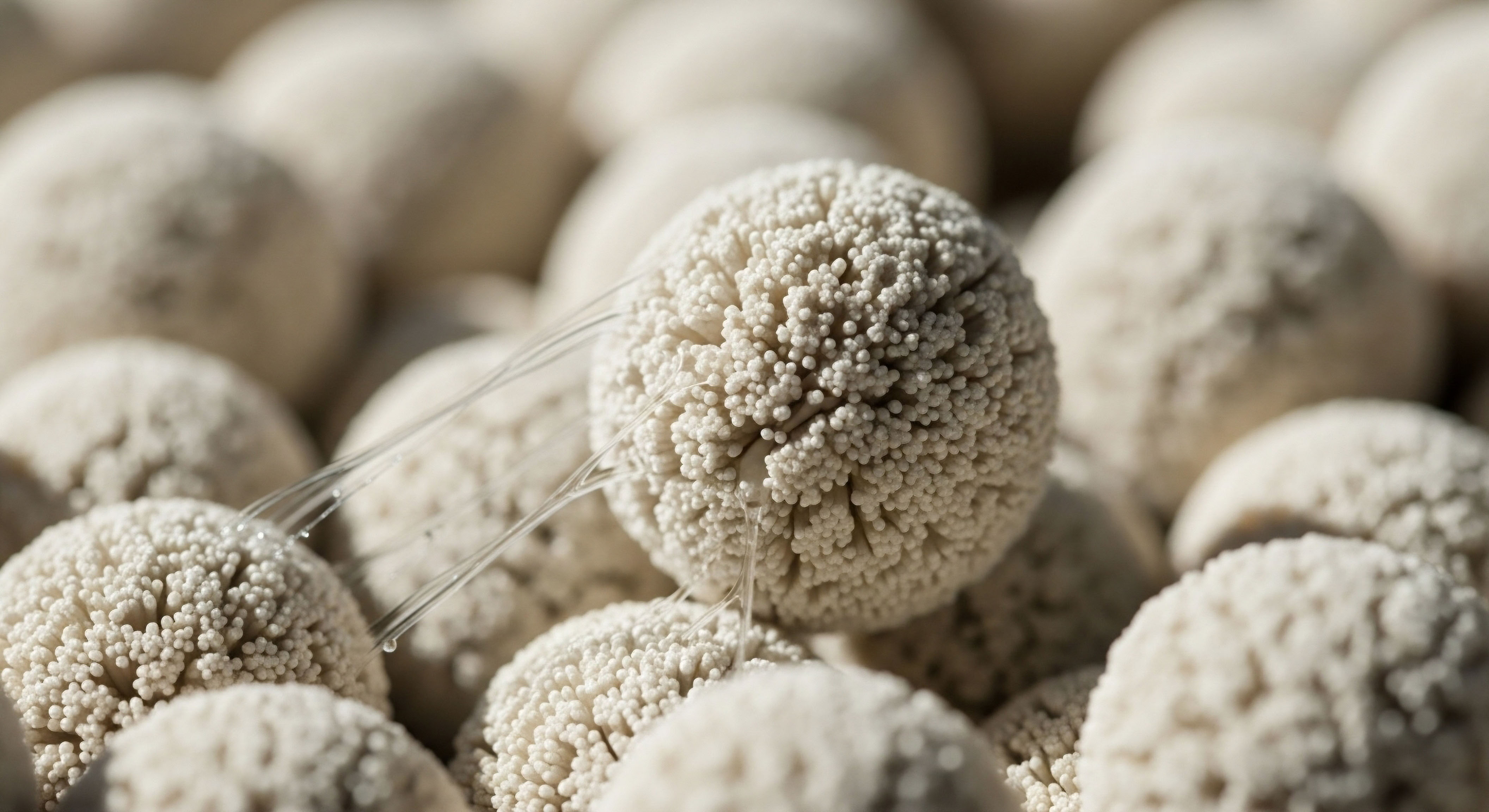

Fundamentals
Many men experience a subtle yet persistent shift in their well-being, a quiet erosion of the vitality they once knew. This often manifests as a creeping fatigue, a diminished drive, or a sense that their physical and mental sharpness has dulled.
Perhaps you have explored avenues for restoring hormonal balance, such as testosterone replacement therapy, seeking to reclaim that lost vigor. The decision to begin such a regimen is a significant personal step, often bringing welcome improvements in energy, mood, and physical capacity. However, the journey with hormonal support does not always conclude with the cessation of therapy.
For some, discontinuing exogenous testosterone prompts a new set of considerations, requiring a thoughtful approach to guide the body back to its own rhythm.
Understanding the body’s intricate internal communication network is paramount. Hormones serve as chemical messengers, orchestrating countless physiological processes, from metabolism and mood to muscle development and reproductive function. When external testosterone is introduced, the body’s own production mechanisms, primarily the hypothalamic-pituitary-gonadal (HPG) axis, often reduce their activity.
This axis functions like a sophisticated internal thermostat, constantly monitoring and adjusting hormone levels. When the brain senses sufficient testosterone from an external source, it signals the testes to decrease their natural output.
The body’s hormonal system, particularly the HPG axis, adjusts its natural production when external testosterone is introduced.
The concept of a post-TRT protocol arises from this physiological adaptation. It addresses the period following the discontinuation of external testosterone, when the body’s inherent systems need encouragement to resume their full, natural output.
This is not a universal requirement for every man who stops testosterone support, but it becomes a significant consideration for those whose endogenous production has been substantially suppressed or for individuals aiming to restore fertility. The goal is to facilitate a smoother transition, supporting the body’s return to a state of self-sufficiency in hormone generation.

The Body’s Endocrine Orchestra
The endocrine system operates as a finely tuned orchestra, with various glands and organs playing distinct roles to maintain internal equilibrium. The hypothalamus, located in the brain, initiates the hormonal cascade by releasing gonadotropin-releasing hormone (GnRH). This signal travels to the pituitary gland, also in the brain, which then releases two critical hormones ∞ luteinizing hormone (LH) and follicle-stimulating hormone (FSH). These gonadotropins then travel through the bloodstream to the testes, stimulating them to produce testosterone and sperm.
When exogenous testosterone is administered, this feedback loop is interrupted. The brain perceives high levels of circulating testosterone and, in response, reduces its output of GnRH, LH, and FSH. This suppression of the HPG axis leads to a decrease in the testes’ natural testosterone production and, consequently, sperm production. This physiological response is a normal adaptation to external hormonal input.

Why Consider Post-TRT Support?
For men who have been on testosterone support for an extended duration, the HPG axis may require assistance to reactivate efficiently. Without proper support, some individuals might experience a period of low natural testosterone production, leading to symptoms similar to those that prompted the initial therapy, such as fatigue, mood changes, reduced libido, and diminished physical capacity. This transitional phase can be challenging, impacting daily life and overall well-being.
A structured post-TRT protocol aims to mitigate these potential challenges. It provides specific agents designed to stimulate the body’s own hormone-producing machinery, helping to restore the HPG axis to its optimal function. This proactive approach supports the body’s inherent capacity for self-regulation, guiding it back to a balanced state. The objective is to minimize the duration and severity of any hypogonadal symptoms that might arise during this period of recalibration.


Intermediate
Transitioning away from exogenous testosterone requires a deliberate strategy to reactivate the body’s intrinsic hormonal systems. A post-TRT protocol is a carefully constructed regimen designed to encourage the hypothalamic-pituitary-gonadal (HPG) axis to resume its natural production of testosterone and support spermatogenesis.
This approach is particularly relevant for men who have experienced significant suppression of their endogenous production during therapy or those prioritizing the restoration of fertility. The agents employed in these protocols work synergistically to stimulate different points within the HPG axis, guiding the body back to its own hormonal equilibrium.

Agents for Endocrine Recalibration
Several pharmaceutical agents are commonly utilized in a post-TRT protocol, each with a distinct mechanism of action aimed at stimulating the HPG axis. These agents are selected based on an individual’s specific needs, the duration of prior testosterone support, and their personal health objectives.
- Gonadorelin ∞ This synthetic peptide mimics the action of natural gonadotropin-releasing hormone (GnRH), which is produced by the hypothalamus. By administering Gonadorelin, typically via subcutaneous injections, the pituitary gland is stimulated to release luteinizing hormone (LH) and follicle-stimulating hormone (FSH). This direct stimulation helps to awaken the pituitary’s signaling function, which may have become dormant during exogenous testosterone administration. Gonadorelin helps to maintain testicular size and function during TRT, and it is also a key component in post-TRT recovery.
- Tamoxifen ∞ As a selective estrogen receptor modulator (SERM), Tamoxifen primarily blocks estrogen’s negative feedback on the hypothalamus and pituitary. Estrogen, derived from testosterone through the enzyme aromatase, can suppress GnRH and LH/FSH release. By blocking estrogen receptors in the brain, Tamoxifen effectively “tricks” the hypothalamus and pituitary into perceiving lower estrogen levels, thereby increasing the release of GnRH, LH, and FSH. This leads to enhanced testicular testosterone production.
- Clomid (Clomiphene Citrate) ∞ Similar to Tamoxifen, Clomid is also a SERM. It acts by blocking estrogen receptors in the hypothalamus and pituitary, thereby disinhibiting the release of GnRH, LH, and FSH. Clomid is widely used to stimulate endogenous testosterone production and is particularly effective in restoring spermatogenesis, making it a frequent choice for men seeking to regain fertility after testosterone support.
- Anastrozole ∞ This medication is an aromatase inhibitor (AI). Aromatase is the enzyme responsible for converting testosterone into estrogen. While some estrogen is necessary for male health, excessive levels can lead to side effects such as gynecomastia and can also suppress the HPG axis. Anastrozole reduces estrogen levels by inhibiting this conversion, thereby preventing estrogen-mediated negative feedback and allowing for higher endogenous testosterone levels. It is used judiciously, as excessively low estrogen can also be detrimental.
Post-TRT protocols employ agents like Gonadorelin, Tamoxifen, Clomid, and Anastrozole to reactivate the body’s natural hormone production.

Protocol Design and Administration
The specific dosage and duration of a post-TRT protocol are highly individualized, determined by factors such as the length and dosage of prior testosterone support, the individual’s baseline hormonal status, and their response to the protocol. A typical protocol might involve a combination of these agents, administered over several weeks or months.
For instance, a common approach involves weekly subcutaneous injections of Gonadorelin, often twice per week, to directly stimulate the pituitary. This might be paired with oral tablets of Tamoxifen or Clomid, also administered twice weekly, to block estrogenic feedback and further boost LH and FSH release. Anastrozole may be included if estrogen levels are elevated, ensuring a balanced hormonal environment during recovery.

Monitoring and Adjustments
Regular monitoring of blood work is essential throughout the post-TRT period. This includes assessing levels of total and free testosterone, LH, FSH, and estradiol (estrogen). These measurements provide critical feedback on the HPG axis’s recovery and allow for precise adjustments to the protocol. The goal is to observe a progressive increase in natural testosterone production and a return of LH and FSH levels to a healthy range.
The table below provides a general overview of the primary agents used in post-TRT protocols and their mechanisms.
| Agent | Primary Mechanism of Action | Target in HPG Axis |
|---|---|---|
| Gonadorelin | Mimics GnRH, stimulating pituitary release of LH/FSH | Hypothalamus/Pituitary |
| Tamoxifen | Blocks estrogen receptors in hypothalamus/pituitary | Hypothalamus/Pituitary |
| Clomid | Blocks estrogen receptors in hypothalamus/pituitary | Hypothalamus/Pituitary |
| Anastrozole | Inhibits aromatase enzyme, reducing estrogen conversion | Peripheral Tissues/Estrogen Levels |
The duration of recovery varies among individuals. Some men may see a rapid return to baseline hormonal function, while others may require a more extended period of support. Patience and consistent adherence to the protocol, coupled with diligent monitoring, are vital for a successful transition. The aim is to restore the body’s capacity to produce its own testosterone, promoting long-term hormonal health and overall well-being.


Academic
The cessation of exogenous testosterone administration initiates a complex physiological recalibration within the male endocrine system, primarily centered on the re-establishment of the hypothalamic-pituitary-gonadal (HPG) axis‘s intrinsic functionality. This intricate neuroendocrine feedback loop, which governs endogenous testosterone production and spermatogenesis, undergoes significant suppression during periods of external androgenic input. A deep understanding of the molecular and cellular mechanisms underlying this suppression and subsequent recovery is essential for designing effective post-TRT protocols.

HPG Axis Recalibration Dynamics
During testosterone replacement therapy, the supraphysiological or even physiological levels of circulating exogenous testosterone exert a potent negative feedback effect on the hypothalamus and pituitary gland. Specifically, testosterone, and its aromatized metabolite estradiol, bind to androgen receptors (AR) and estrogen receptors (ER) respectively, within the hypothalamus and anterior pituitary.
This binding inhibits the pulsatile release of gonadotropin-releasing hormone (GnRH) from the hypothalamus and, consequently, the secretion of luteinizing hormone (LH) and follicle-stimulating hormone (FSH) from the pituitary gonadotrophs. The diminished LH signaling to the Leydig cells in the testes leads to a reduction in testosterone biosynthesis, while reduced FSH signaling impairs Sertoli cell function and spermatogenesis.
Exogenous testosterone suppresses the HPG axis by inhibiting GnRH, LH, and FSH release through negative feedback.
The duration and dosage of prior testosterone administration significantly influence the degree and persistence of HPG axis suppression. Prolonged suppression can lead to Leydig cell desensitization or atrophy, making the recovery phase more challenging. The objective of a post-TRT protocol is to pharmacologically counteract this suppression and stimulate the axis back into active production.

Pharmacodynamics of Recovery Agents
The agents employed in post-TRT protocols target specific points within this feedback loop to restore function.

Gonadorelin and GnRH Receptor Agonism
Gonadorelin, a synthetic decapeptide, is chemically identical to endogenous GnRH. Its administration provides a direct, pulsatile stimulus to the GnRH receptors on the anterior pituitary gonadotrophs. This pulsatile stimulation is critical, as continuous GnRH receptor activation can lead to desensitization and downregulation, a principle exploited by GnRH agonists used in prostate cancer therapy.
By mimicking the natural pulsatile release of GnRH, Gonadorelin prompts the pituitary to synthesize and secrete LH and FSH. LH then acts on Leydig cells in the testes, stimulating the rate-limiting step in testosterone synthesis, the conversion of cholesterol to pregnenolone by the cholesterol side-chain cleavage enzyme (P450scc). FSH, conversely, supports Sertoli cell function, which is essential for spermatogenesis. The precise pulsatile delivery of Gonadorelin is paramount for its efficacy in stimulating, rather than suppressing, gonadotropin release.

Selective Estrogen Receptor Modulators (SERMs)
Tamoxifen and Clomiphene Citrate are SERMs that exert their primary effect by competitively binding to estrogen receptors in the hypothalamus and pituitary gland. These compounds act as antagonists in these specific tissues, preventing endogenous estradiol from binding and exerting its negative feedback. This blockade effectively “releases the brakes” on GnRH and gonadotropin secretion.
The resulting increase in GnRH pulsatility drives elevated LH and FSH levels, which in turn stimulate testicular testosterone production and spermatogenesis. Clomiphene, in particular, has been extensively studied for its ability to restore spermatogenesis in hypogonadal men, even those with secondary hypogonadism. Its efficacy stems from its ability to increase intratesticular testosterone concentrations, which are significantly higher than circulating levels and are crucial for sperm maturation.

Aromatase Inhibitors (AIs)
Anastrozole is a non-steroidal aromatase inhibitor. It functions by reversibly binding to the heme group of the aromatase enzyme, thereby preventing the conversion of androgens (primarily testosterone) into estrogens. While estrogen is vital for bone health and other physiological processes in men, excessive estradiol levels can suppress the HPG axis and contribute to symptoms such as gynecomastia.
By reducing circulating estradiol, Anastrozole diminishes the negative feedback on the hypothalamus and pituitary, allowing for increased GnRH, LH, and FSH secretion. This indirectly supports higher endogenous testosterone levels. The careful titration of AI dosage is necessary to avoid excessively low estrogen levels, which can negatively impact bone mineral density, lipid profiles, and mood.
The interplay of these agents creates a multi-pronged approach to HPG axis recovery. Gonadorelin provides direct pituitary stimulation, while SERMs and AIs modulate the negative feedback loops, allowing the axis to reactivate. The success of these protocols relies on a precise understanding of their pharmacokinetics and pharmacodynamics, coupled with rigorous biochemical monitoring.
| Hormone/Enzyme | Role in HPG Axis | Impact of TRT | Target for Post-TRT Protocol |
|---|---|---|---|
| GnRH | Hypothalamic signal to pituitary | Suppressed pulsatility | Stimulated by Gonadorelin, disinhibited by SERMs |
| LH | Pituitary signal to Leydig cells for T production | Suppressed secretion | Stimulated by Gonadorelin, disinhibited by SERMs |
| FSH | Pituitary signal to Sertoli cells for spermatogenesis | Suppressed secretion | Stimulated by Gonadorelin, disinhibited by SERMs |
| Testosterone | Primary male androgen, produced by testes | Exogenous replaces endogenous, leading to suppression | Endogenous production restored by protocol agents |
| Estradiol | Aromatized from testosterone, negative feedback | Elevated with exogenous T, contributes to suppression | Reduced by Aromatase Inhibitors (Anastrozole) |
The ultimate aim of these sophisticated biochemical recalibration protocols is to restore the body’s innate capacity for hormonal self-regulation, allowing men to maintain physiological testosterone levels without external dependency, and to regain reproductive capacity if desired. This systems-biology perspective acknowledges the interconnectedness of endocrine pathways and guides interventions that support the body’s inherent drive toward equilibrium.

References
- Hayes, F. J. et al. “Gonadotropin-releasing hormone pulsatile administration in the treatment of male hypogonadotropic hypogonadism.” Journal of Clinical Endocrinology & Metabolism, vol. 84, no. 1, 1999, pp. 300-305.
- Shabsigh, R. et al. “Clomiphene citrate for the treatment of hypogonadism.” BJU International, vol. 100, no. 6, 2007, pp. 1402-1406.
- Kovac, J. R. et al. “Testosterone replacement therapy and fertility ∞ is there a role for human chorionic gonadotropin?” Translational Andrology and Urology, vol. 4, no. 5, 2015, pp. 641-649.
- Mahesh, V. B. and R. B. Greenblatt. “The mechanism of action of clomiphene citrate.” Journal of Clinical Endocrinology & Metabolism, vol. 22, no. 4, 1962, pp. 803-809.
- Miller, W. R. and A. L. Brodie. “Aromatase inhibition ∞ from bench to bedside.” Journal of Steroid Biochemistry and Molecular Biology, vol. 102, no. 1-5, 2006, pp. 1-10.
- Boron, W. F. and E. L. Boulpaep. Medical Physiology. 3rd ed. Elsevier, 2017.
- Guyton, A. C. and J. E. Hall. Textbook of Medical Physiology. 14th ed. Elsevier, 2020.

Reflection
Your personal health trajectory is a dynamic process, a continuous dialogue between your biological systems and the choices you make. The information presented here serves as a guide, offering a deeper understanding of the intricate mechanisms governing hormonal balance, particularly in the context of transitioning from external support. Consider this knowledge a foundational element in your ongoing pursuit of well-being.
Each individual’s biological response is unique, shaped by a confluence of genetic predispositions, lifestyle factors, and prior medical interventions. The insights gained from exploring post-TRT protocols underscore the importance of a personalized approach to health. It prompts us to consider not just isolated symptoms, but the interconnectedness of all bodily systems. What steps might you take to further align your daily practices with your body’s inherent drive toward equilibrium?
This exploration invites you to view your body not as a collection of separate parts, but as a unified system capable of remarkable adaptation and self-correction when provided with the right support. The path to optimal vitality is often one of continuous learning and thoughtful adjustment. How might this understanding reshape your perspective on your own capacity for health and resilience?



